India:
Making Food a Right for All
India has made considerable progress in tackling hunger and undernutrition in the past two decades, yet this pace of change has been uneven and many have been left behind. Now is the time to assert the right to food for all and make Zero Hunger a reality for everyone.
When you have your godowns (warehouses) full and people are starving, what is the benefit? You cannot have two Indias. Dalveer Bhandari, Judge of India’s Supreme Court, 21 April 2011
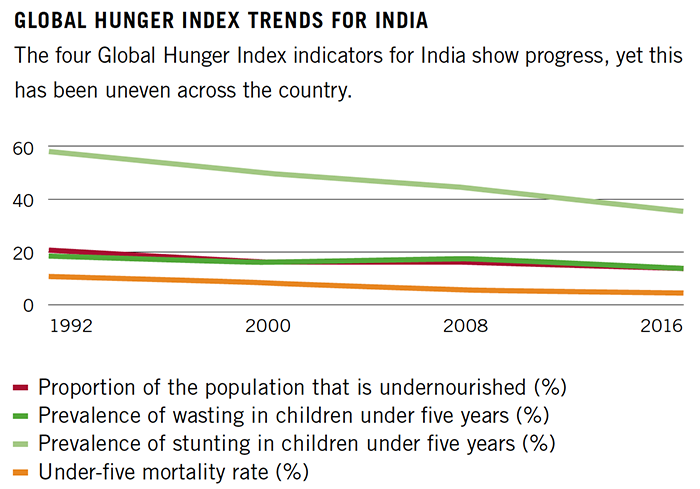
India is a country of stark contrasts. In total, 22% of its population lives below the poverty line (Government of India 2013). At the same time, it is home to 84 of the world’s billionaires (Forbes 2016).
India’s top 1% own more than 50% of the country’s wealth. It is the world’s second largest food producer and yet is also home to the second-highest population of undernourished people in the world (FAO 2015).
One side of this story is clear from the score for India on the Global Hunger Index (GHI) – 28.5 (von Grebmer et al 2016). By contrast, Brazil, Russia, China and South Africa, all of whom share the BRICS high table with India, have a single-digit score. India’s neighbours, including Bangladesh, Nepal, Sri Lanka and Myanmar, have better GHI scores as well. Although the country has managed to reduce instances of stunting among children by nearly half in the past decade compared to the previous one (IFPRI 2015), India remains home to one third of the world's stunted children (UNICEF et al. 2016). It therefore falls into the ‘serious’ category in this year’s (2016) GHI.
Now, the 2030 Agenda for Sustainable Development is seeking to end hunger, achieve food security, improve nutrition and promote sustainable agriculture. The tangible outcomes will be to eradicate instances of stunting among children and guarantee every citizen with access to adequate food throughout the year through sustainable food systems, the doubling of smallholder productivity and income, and zero food loss or waste.
Although rainfed agriculture supports nearly 40% of India’s population (Government of India 2012), these farmers are highly sensitive to drought, which can cause crops to fail and lead to spiralling debt.
The key driver behind the goal to reach Zero Hunger and malnutrition is to ensure that no one is left behind in the pursuit of food and nutrition security. In the Indian context, this will also mean greatly improving the health of women and children.
The Government of India enacted the National Food Security Act (NFSA) in 2013, a law seeking to “provide for food and nutritional security […] by ensuring access to adequate quantity of quality food at affordable prices to people to live a life with dignity” (Ministry of Law and Justice 2013).
The 2013 NFSA created legal entitlements to existing governmental food and nutrition security programmes. Most significantly, it has changed the nature of discourse on food, making it a human right and putting the onus on the state to guarantee basic entitlements. However, the question is whether the quality of life has actually improved for everyone in the meantime. The food provided by the Government through its procurement and disbursement schemes serves the calorific requirement for some of the population. However, the system has also altered their food habits, made them dependent on rice and wheat and eliminated traditional diet diversity, thereby reducing the micronutrient content of the food on their plates.
Those Left Behind
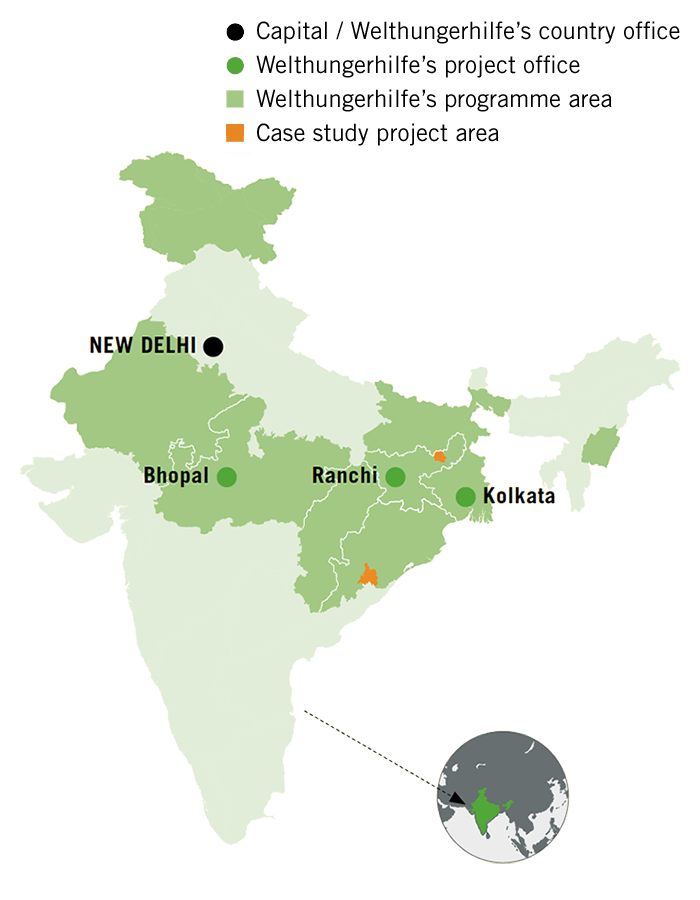
Among the poorest people in India are those who belong to Scheduled Castes and Scheduled Tribes – traditionally oppressed classes for whom the Indian constitution provides special affirmative provisions to promote and protect their social, educational and economic interests.
The Scheduled Castes include millions of Dalits, or ‘untouchables’, who continue to be subject to endemic discrimination. This is also the case for the Scheduled Tribes, which comprise indigenous people, also known as Adivasis, who are often disadvantaged, in part because of the forested geographies in which they live.
As a consequence, Dalits and Adivasis are over-proportionally affected by poverty. With 104 million people belonging to nearly 700 distinct ethnic groups, India has the second-largest tribal population in the world (Government of India 2011). 47% of the rural tribal population lives below the national poverty line, compared to the national average for rural areas of 28% (Rao 2012). The level of poverty and food and nutrition insecurity of the tribal people continues to be a major issue, despite the affirmative action put in place by the architects of India’s Constitution for their protection and welfare.
The Adivasis have borne witness to the appropriation of their lands, destruction of their environment and commoditisation of their traditional knowledge – a lopsided bargain which has come at the cost of their way of life and well-being, beginning with their health and the security of resources for future generations. Safeguards such as informed consent have been thrown to the winds in the rush to acquire and trade forest produce and land on a large scale.
The problems faced by the indigenous people of India are further iterated by a recent study conducted by the United Nations Children´s Fund (UNICEF). Covering 11 states, it shows that every second Adivasi child is stunted, 68% of Adivasi mothers are less than 20 years old, 48% are undernourished and 76% are anaemic. Furthermore, the study states that the risk of severe stunting is nearly twice as high among girls aged 6-23 months compared to boys (UNICEF 2014). This may be due to food distribution practices within households and gender discrimination, resulting in woman receiving less food or men being served the best portions.
The efforts of the Food Security Act and a range of other laws to tackle these issues have encountered many challenges. Adivasi hamlets are often remote and poorly connected, making logistics and monitoring difficult. Indeed, the plight of those who suffer from hunger is only addressed when deaths resulting from starvation momentarily lead to public outrage. These are the groups that need support most urgently.
Growing Rich Diversity with Limited Land
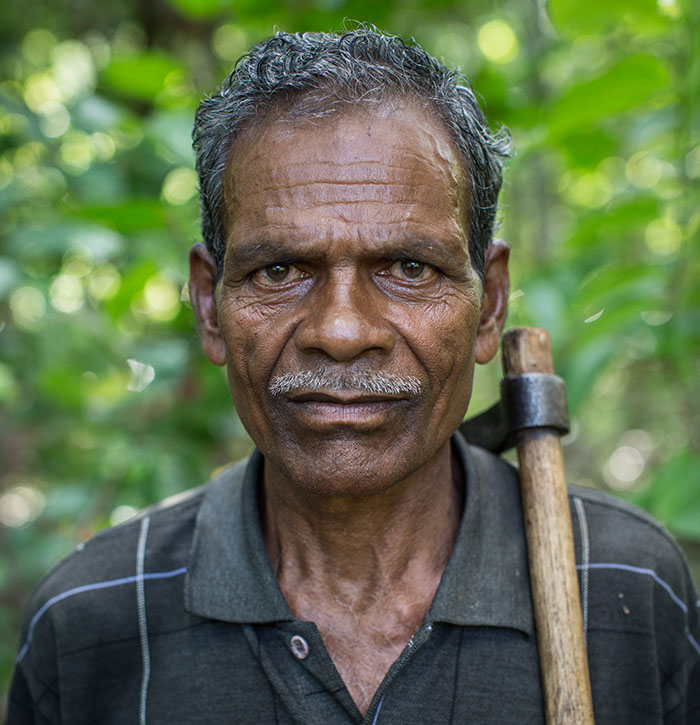 Loknath Nauri, Kerandiguda village, Rayagada, Odisha
Loknath Nauri, Kerandiguda village, Rayagada, Odisha
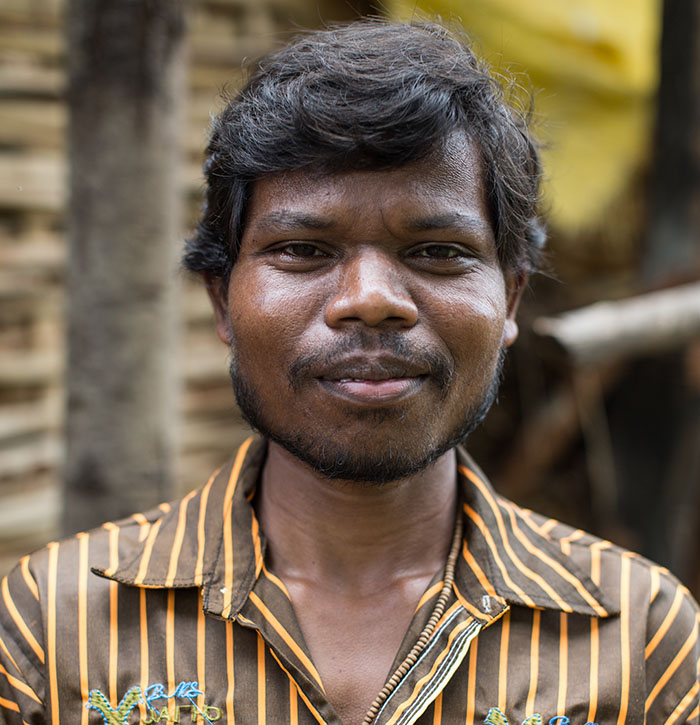
My friends were avoiding farming. I told them that we can’t afford to let the varieties of our village get lost. Last year, I grew 70 varieties. It sufficed us for the year. This year I have told fellow villagers to grow 80 varieties Adi Kumbruka, young farmer in Kanduguda village, Odisha
Welthungerhilfe has been working in India since 1965. As part of its current efforts, it is increasingly focusing on mobilising and raising awareness among the marginalised and poor rural communities in order to help them access their rights and entitlements in relation to hunger and poverty.
Welthungerhilfe’s approaches address the four pillars of food and nutrition security, namely ensuring the availability of food of sufficient quantity and quality, guaranteeing that people have physical and economic access to this food, providing health and sanitation conditions that enable them to truly benefit from this food, and ensuring that these factors are stable all year round.
Welthungerhilfe works with a number of civil society partners across the country implementing a rights-based approach that addresses these four aspects of food and nutrition security. Many of these projects are established in states and regions suffering from extremely high levels of malnutrition.
Living Farms, a partner NGO, works with landless, small and marginalised farmers in the dry, hilly region of the state of Odisha in Eastern India to help them assert their food sovereignty and improve their well-being by means of an ecological and sustainable approach to agriculture. To this end, Living Farms is working to re-establish the control of these farmers over food and farming systems through the conservation, renewal and rejuvenation of biodiversity. Availability of food is improved at household level by initiating a series of interventions to enhance productivity on the limited land they have.
In the Kerandiguda village of Rayagada, Living Farms is working with Loknath Nauri (pictured), a farmer in his sixties who draws inspiration from how tribal people practised agriculture decades ago. Loknath is a repository of wisdom. For example, he can tell the direction the yearly rains will come from based on how a local bird’s nest is positioned. He can also predict when it will rain purely using the beans in the pods of a local creeping plant. These are just two of the many lessons he shares with other farmers. Although Loknath owns just 2.5 acres (1ha) of land, his food stocks at home are plentiful. He grows 72 different varieties of crops on his farm:
Growing multiple varieties of crops reduces the risks from drought and other farm stress. I harvest from September until January and have vegetables throughout the year.
Living Farms has an extensive list of small land-holding farmers who grow over 50 different varieties on their farms. Thousands more cultivate over 20 crop varieties and no longer have to endure the type of crisis faced by farmers in other rain-fed agricultural regions around the country. This stability is important, as farmers can otherwise become lured into growing cash crops instead, such as cotton, cashew, palm oil, sugarcane and eucalyptus, which reduces food availability.
Debjeet Sarangi from Living Farms explains that the NGO is working with researchers to rediscover the virtues of traditional local crop varieties that can withstand erratic rainfall and soaring temperatures and still produce bountiful yields.
The community already has traditional rice varieties that are rich in micronutrients, zinc, iron, magnesium and calcium, while scientists are working on creating such seeds in laboratories around the world.
...Debjeet says, adding that the Adivasis avoid using chemicals on their farms and make their own compost instead.
In Jharkhand, Pravah, another Welthungerhilfe partner, encourages landless families to set up kitchen gardens in their homesteads and harness common fallows to grow food for the family. On the farmlands, diversity is returning through the ‘Sustainable Integrated Farming Systems’ approach, which functions according to the principle of farm planning and the use of all available resources, including time and space, as efficiently as possible. Hardy, drought-resilient millet crops are now being reintroduced to the cropping cycle. Waste from livestock, poultry and aquaculture is recycled through a bio-digester in order to provide rich farm manure, and agroforestry is practised to provide fodder for animals.
Space on the homestead as well as on the farm is used to grow different crops, sometimes in multiple tiers. Crops are planned in such a way that food is available throughout the year, thereby resulting in different food products for the market. In addition, this directly addresses micronutrient deficiency and leads to diet diversity among the population.
Pravah has worked closely with farmers like Nandlal Singh, who owns 2.5 acres of land. Nandlal’s story was similar to any other farmer’s in the region, namely one of debt, crop failure, migration and mortgages. His situation has now changed. Thanks to farm planning and integrated farming Nandlal has not only cleared his old debts, but has money in the bank. Pravah’s training on vermicomposting, organic farming and integrated pest and nutrient management techniques have proven successful and led to the production costs on Nandlal’s farm being reduced.
The family has a diverse diet which incorporates up to eight food groups, including cereals, lentils, fruits and vegetables. Nandlal grows these vegetables throughout the year while also rearing cattle, fish and ducks on what was once a patch of wasteland.
A striking feature of the work of both organisations is the low incidence of indebted households among the farmers involved in the programme. Small and marginal farmers like Nandlal Singh and Loknath are not short of the resources they need for this kind of farming. This reduces their reliance on loans and avoids the problems associated with debt. Debjeet Sarangi from Living Farms cites examples of how farmers who used to be impoverished now grow multiple crops per year and how, together with poultry and animal husbandry, they are able to safeguard their families against food and nutrition insecurity. But, most importantly, Debjeet says, they depend on forests.
Securing Forests to Secure Nutrition
15.2%
of the Indian population is undernourished, meaning that they do not receive enough calories per day
38.7%
of children under five are stunted (low height for their age), reflecting chronic undernutrition
15.1%
of children under five are wasted (low weight for their height), reflecting acute undernutrition
4.8%
of children die before the age of five
The diet of the Adivasi people used to be a highly diverse one. However, years of planning and the Government’s control over resources meant that these tribal farmers began to lose the ability to cultivate the seeds that kept their people fed for generations. One result of these developments is that the diversity of the crops grown and of the available forest resources has shrunk massively over the years.
...explains Debjeet. Debjeet alludes to evidence that vast swathes of forests are being acquired fraudulently:
Officials only see it as lost forest when in actual fact the loss of these forests is also affecting the eating habits and the nutrition of the tribal people. The range of forest fauna, flowers, fruits, vegetables and mushrooms previously consumed by tribal people has diminished over time due to governmental policies. Tribal people collect 25 varieties of roots and tubers, 35 kinds of fruits and various oil seeds from the forests. The forest also provides 40 different leaf vegetables, mushrooms and various birds, animals, edible insects and other food sources throughout the year. In addition, the bodies of water belonging to the forests are home to an abundance of snails, fish and crab.
This diversity offered by the forests is now under threat and entire species have disappeared, thus depriving families of a varied diet.
Women in Rayagada are now resisting the forest department’s attempts to plant commercial trees, demanding that multipurpose trees are planted instead. The move has led to the protection of forest cover and the revival of over 275 varieties of wild foods that provide food rich in micronutrients.
Rua Ulaka, a farmer from the village of Lanji, Rayagada, is part of this active citizenship movement, as evidenced by the level of care that she shows for her forests and its ecosystem. By working together, the Adivasis are able to ensure that this asset is not commercialised. Ultimately, the work carried out by Living Farms and Pravah has shown that families with very small landholdings and continued access to the forest are more than able to survive another year. With dignity.
Fighting the Day-to-Day Nutrition Crisis
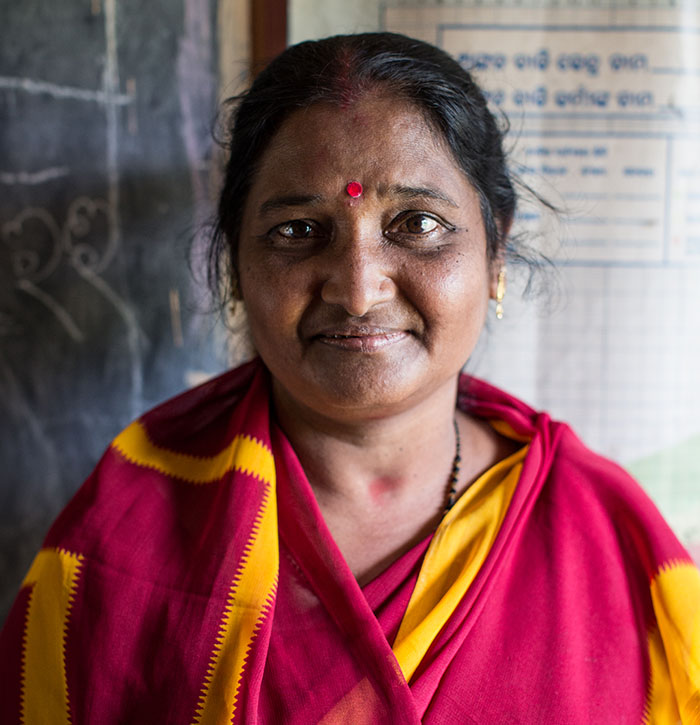
Previously, women would not have their babies weighed or breast-feed their newborns due to superstition. This has changed. Mothers now ask me how much their child weighs. Women wear slippers, families have toilets, girls are resisting early marriage and babies are being born in hospitals. Not a single child has died in this village over the past five years. Sharmishta Raj, Anganwadi worker at the center of Laxmipur village in Odisha
As well as working to ensure the availability of sufficient and nutritious food, both organisations promote awareness and changes in behaviour at community level in terms of health care and infant and young child feeding practices.
A promising approach introduced by Pravah in the villages of Jharkhand consists of ‘Positive Deviance Sessions’, whose aim is to improve the health of moderately malnourished children. With 15% of children below five years of age being classified as underweight for their height, India’s acute malnutrition rate is at the international threshold that indicates a nutrition emergency. Babita Sinha, Pravah’s Programme Manager, explains:
80% of the children in the nutrition camps have recorded weight gain and have shifted from the Moderate Acute Malnutrition (MAM) category to the category of healthy children. This is due in part to a 15-day hands-on camp to introduce young and pregnant mothers to new, nutritious recipes, gathering and using nutritious, uncultivated food, child-care practices and hand-washing.
These ‘Positive Deviance Camps’ have also implemented de-worming programmes and helped to change the behaviour of young parents in various villages. According to Babita, the mothers realised that their children were responding positively to these initiatives when they were weighed. She recalls:
Seeing a gain of 500 grams in the child’s weight gave the mothers tremendous joy.
The sensitisation process was revealing for the experts at Pravah as well. “We were able to understand why children in the red category (meaning those belonging to the lowest-weight-for-age section of the WHO Growth Monitoring Charts, signifying malnutrition) belonged to families from certain clusters of the villages,” states Sweta Banerjee, Nutrition Specialist with Welthungerhilfe in India. Sweta bore witness to how the process taught the village communities to link nutrition with good agriculture practices and proper management of natural resources.
As she states, “We realised it was not a coincidence that these children came from families that were either landless or owned land uphill that was not irrigated. As such, the nutrition programme had to be amended to benefit them.”
One key breakthrough was that women were able to grasp how the nutrition chain between generations could be broken by paying attention to the nutritional needs of different age and gender groups and by including adolescent girls, expectant mothers and women nursing children. The Pravah team noted that close to half of the households in the villages in which they were working have since improved their food and diet practices. There have also been visible changes in personal hygiene practices at household level. Combined, these actions will have a lasting impact on the health of the people living in these villages.
Putting the Right to Food into Action
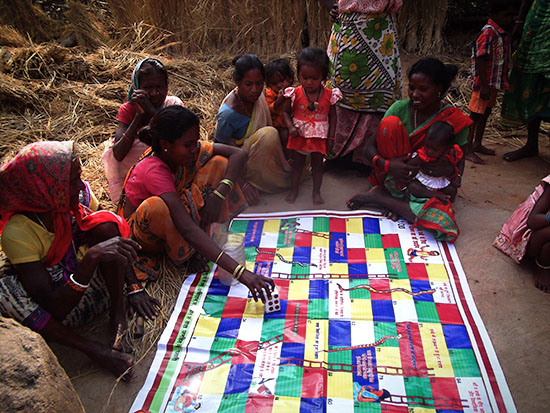 The traditional game of Snakes and Ladders has been adapted to inform mothers about infant care and health. Ladders represent good practices, while snakes highlight dangers, Pahtri village, Deoghar, Jharkhand. Photo: Pravah, Jharkhand.
The traditional game of Snakes and Ladders has been adapted to inform mothers about infant care and health. Ladders represent good practices, while snakes highlight dangers, Pahtri village, Deoghar, Jharkhand. Photo: Pravah, Jharkhand.
The Fight Hunger First Initiative implemented by Welthungerhilfe in cooperation with several Indian partner organisations, including Living Farms and Pravah, is based on the premise that it is only possible for people to break out of the cycle of inequality and discrimination permanently if adequate welfare systems are in place and basic rights are fulfilled.
This includes access to proper education, sufficient and adequate access to food and income, better health services and treatment as equal citizens by the state.
The right to food guaranteed by the Food Security Act is translated into a number of entitlements ensured through different programs. Examples include the Integrated Child Development Services (ICDS), which provides health and nutrition services to pregnant women and young children, and the Mid-Day Meals (MDM) scheme, which is aimed at providing free lunches and thereby improving the nutritional status and attendance of school children.
Meanwhile, the National Rural Employment Guarantee Act (NREGA) guarantees the provision of paid employment to rural families. In some cases, it has reduced reliance on the Public Distribution System (PDS), which distributes subsidised food rations to those who are most in need.
Enforcement of the National Food Security Act is a challenge, especially in far-flung villages. In addition, many families have little access to work for wages that could be used to buy food, educate children and cover other household expenses.
At national level, for example, households covered by the Rural Employment Act, on average, only received 41 days of work per year between 2011/12 and 2013/14 (Desai et al 2015). This equates to less than half the amount set out in the constitutional provisions. The situation is similar in Jharkhand. Rather ironically, the Government has increased the minimum number of days of work to which the households are entitled under the law to 150.
As part of the Fight Hunger First Initiative, community-based organisations are formed or strengthened and social accountability mechanisms such as community score cards are introduced as a means of empowering community members to access various forms of entitlements and holding service providers accountable. In the state of Jharkhand, Pravah successfully campaigned with 13 Non-Governmental Organisations (NGOs) for the inclusion of eggs in the Mid-Day-Meals at schools three times a week. Likewise, Living Farms has been able to persuade Government authorities to include millets in the ICDS programme, especially in the form of take-home rations for pregnant women. Persuading ICDS officials to appreciate community inputs has been a lesson in advocacy.
“Community members feel the services do not make sense. On the other hand, service providers also feel handicapped. The gap is evident and the community participation tools we have employed help to bridge this gap,” says Babita Sinha.
A federation of self-help groups promoted by Pravah offers numerous examples of how leadership has been nurtured among women, who are now able to confront agents working at public distribution system outlets or others charged with managing governmental service provision agencies. At the same time, workers at the Anganwadi centres are now on equal terms with the village women. Rua Ulaka is now aware of her rights and entitlements as a citizen, what she can expect from the village’s own self-governance institution, the Panchayat, and of her right to participate in the Gramsabha (village assembly).
Awareness of these aspects of governance ensures that Adivasi women can demand accountability from those governing them. As a result of the work carried out by Pravah and Living Farms, more households are now receiving work. Furthermore, community access to an array of welfare schemes run by the Government has vastly improved, thereby breaking the cycle of poverty and building the community’s resilience.
By engaging with the Village Health and Nutrition Days and working with institutions like the Village Health Sanitation & Nutrition Committees, the project also strengthens the government health service delivery mechanisms regarding its coverage and quality. Sharmishta Raj and her colleagues from the Anganwadi child care centre in Lakhimpur highlight the difference that working with Living Farms has made thanks to effective communication between the centre and the community.
“Not a single child has died in this village over the past five years,” she says, her face brimming with pride. This is a reflection of how much a small group of front-line government functionaries has achieved through a partnership with a civil society organisation in a remote corner of the country.
Ending a Nutrition Paradox
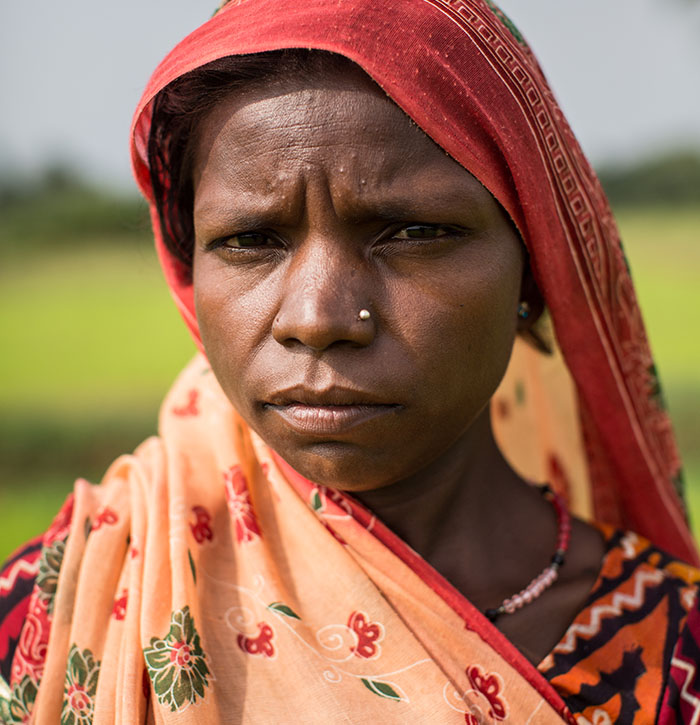
I grow enough and earn enough and can also take advantage of the government’s food schemes. We even have fish once a week and enough fruits and vegetables. Geeta Devya, Dhanway Naya village in Jharkhand
India’s agricultural growth rate increased phenomenally in the decades following the green revolution that turned the country from a “ship-to-mouth economy” into a land able to provide food security.
This growth was propelled by technological changes, major investment in infrastructure such as irrigation, markets and roads, the development of credit institutions, auxiliary services and the facilitation of pricing policies. However, the revolution has come with several significant limitations. As a result, a more ecologically and socially sustainable ‘evergreen revolution’ is needed.
India still faces a long road ahead in its quest to achieve Zero Hunger. Over 25 years since India ushered in its economic reforms, the country’s economy has undergone significant structural transformations, encouraging planners to turn their focus away from agriculture and instead towards the service and manufacturing sectors.
The priority now is to return attention to agriculture and its central role of providing food security, reducing poverty and generating employment. Turning one’s back on agriculture, particularly in a time when the climate is changing considerably, will put the food security of the 1.25 billion people living in India in jeopardy.
The Government has recently set an ambitious target to double the income of farmers by 2022 (The Economic Times 2016). This corresponds to targeted annual agricultural growth of more than 14% per year. More needs to be done to enhance the role that agriculture can play in improving nutrition outcomes, for example via the implementation of cross-sector policies and programmes at national and sub-national levels.
Efforts must also be made to ensure that small-scale, marginal and landless farmers are the true beneficiaries of these policies, as too many people are being left behind in India’s efforts to reach Zero Hunger. This goal can only be achieved when the people who are most excluded are placed at the centre of all action and thinking.
Indian civil society, including Welthungerhilfe’s partners, has been working with these communities to enable them to take control of their own lives and demand their right to food. It has also been working in close cooperation with the Government to implement a range of innovative ideas that address issues of food insecurity and malnutrition in remote corners of the country.
Above all, in this land of plenty it will only become possible to overcome the national nutrition paradox by challenging the social, economic and political structures that lead to the discrimination of the most vulnerable people in India.
About this Case Study
The United Nations Sustainable Development Goals are an inspiring and essential call to action. We are being called upon to end hunger by 2030 for everyone – forever. So how do we respond? How can we make this a reality?
This case study highlights the work of Welthungerhilfe as part of efforts towards achieving zero hunger. Drawing on many years of experience and well-founded evidence, we work with governments and partner organisations to scale up solutions which are both sustainable and sustained.
People are at the heart of these programmes. Their stories highlight the diversity of challenges faced by ordinary people every day: coping with conflict while building resilience, living with as well as tackling social inequality, and dealing with and mitigating the impacts of climate change. Although these challenges are enormous, so, too, is the potential to turn the ambition of the Sustainable Development Goals into a reality for everyone.